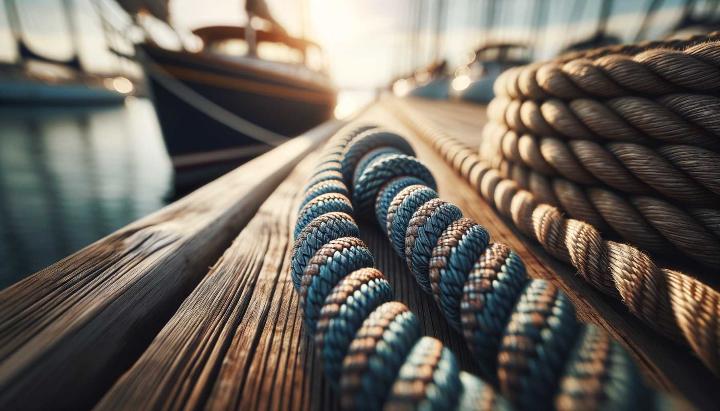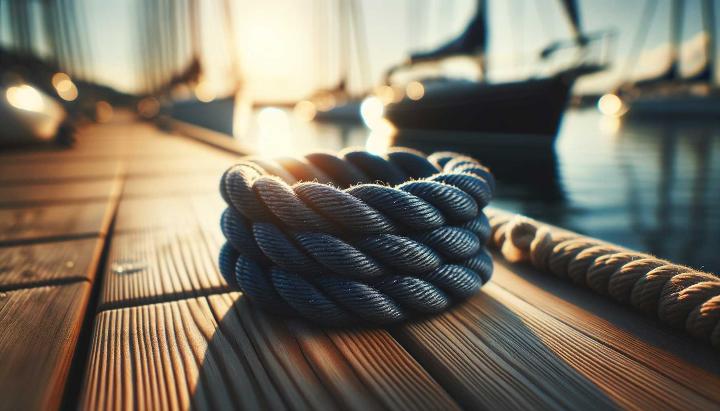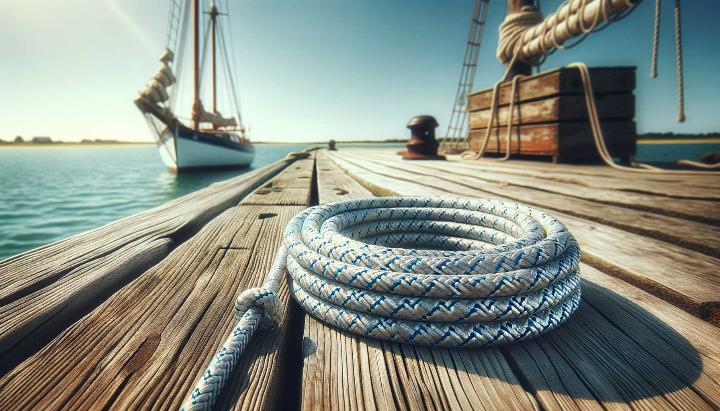Have you ever wondered how a seemingly slender rope can hold a massive yacht securely in place, even in rough seas? The answer lies in the remarkable engineering of double braid ropes. These unassuming workhorses of the maritime world are revolutionising the way we think about strength, flexibility, and durability in cordage.
At iRopes, we've mastered the art of crafting double braid ropes that push the boundaries of what's possible. Our ropes consist of a braided core snugly encased within a braided sheath, creating a powerhouse of strength that outperforms traditional rope designs. But what makes these ropes truly special, and why should you care?
In this guide, we'll unravel the secrets behind double braid rope strength and explore the essential splicing tools that can transform a good rope into an exceptional one. Whether you're a seasoned sailor, an industrial rigger, or simply someone who appreciates top-notch engineering, you're about to discover why double braid ropes are the unsung heroes of countless industries.
From dock lines to complex rigging applications, iRopes' double braid solutions offer unparalleled performance. Join us as we dive into the world of high-strength, flexible, and durable cordage that's changing the game one splice at a time. Are you ready to master the art of double braid ropes?
Understanding the Strength of Double Braid Ropes
Have you ever marvelled at the strength of a seemingly slender rope holding a massive yacht securely in place? That's the magic of double braid ropes at work. Let's dive into the world of these remarkable ropes and uncover the secrets behind their impressive strength.
Comparing Double Braid vs 3 Strand Rope Strength
When it comes to rope strength, not all ropes are created equal. Double braid ropes consistently outperform their 3 strand counterparts in terms of tensile strength. But why is this the case?

The secret lies in the unique construction of double braid ropes. Picture a braided core snugly encased within a braided sheath. This ingenious design allows for a more even distribution of load across the rope's fibres, resulting in superior strength. In fact, double braid ropes can often handle loads up to 20% higher than their 3 strand counterparts of the same diameter.
Factors Affecting Double Braid Rope Strength
The strength of a double braid rope isn't just about its construction. Several factors come into play:
- Material matters: Polyester and nylon are popular choices, each offering unique benefits. Polyester resists UV damage and has low stretch, while nylon provides excellent shock absorption.
- Diameter makes a difference: Generally, the thicker the rope, the stronger it is. However, it's crucial to balance strength with weight and flexibility for your specific application.
- Environmental factors: UV exposure, moisture, and abrasion can all impact a rope's strength over time. That's why proper care and maintenance are essential for longevity.
When choosing a double braid rope, consider the specific demands of your application. Are you rigging a sailboat, securing heavy machinery, or setting up a zip line? Each scenario requires a tailored approach to ensure optimal performance and safety. You can explore more about the specific benefits and applications of marine ropes to guide your decision-making process.
Remember, while tensile strength is crucial, it's measured under controlled laboratory conditions. Real-world performance can vary based on how the rope is used and maintained.
Understanding the nuances of double braid rope strength empowers you to make informed decisions for your specific needs. Whether you're a seasoned sailor or a DIY enthusiast, choosing the right rope can make all the difference in your project's success and safety.
Mastering the Art of Splicing Double Braided Ropes
As a seasoned sailor, I've learned that the true strength of a double braided rope lies not just in its construction, but in how well it's maintained and spliced. Splicing is an art form that can transform a good rope into an exceptional one, ensuring your rigging stays secure in even the most challenging conditions. Consider exploring detailed splicing techniques to enhance your expertise.
Understanding Double Braid Rope Construction
Before we dive into splicing techniques, let's take a moment to appreciate the ingenious design of double braided ropes. Picture a braided core snugly encased within a braided sheath - this unique construction is what gives these ropes their impressive strength and versatility.

The core and cover work in harmony, distributing load evenly and providing excellent resistance to abrasion. Common materials include nylon for its elasticity and shock absorption, polyester for its UV resistance and low stretch, and high-performance fibres like Dyneema for ultimate strength. To better understand the different materials and their performance, consult our guide on nylon and polyester braided ropes.
Step-by-Step Guide to Eye Splicing
Now, let's roll up our sleeves and learn how to create a sturdy eye splice - a skill that will serve you well whether you're rigging a sailboat or securing heavy equipment.
- Gather your tools: You'll need a fid (a tapered tool for separating rope strands), a sharp knife, whipping twine, and measuring tape.
- Mark your measurements: Measure and mark where your eye will begin and end. Remember, a larger eye isn't always better - match the size to your needs.
- Extract the core: Use your fid to carefully separate the core from the cover at your marks. This step requires patience and a gentle touch.
- Taper the core: Trim the extracted core in a tapered fashion to reduce bulk in your final splice.
- Reinsert and form the eye: Thread the tapered core back into the cover, forming your eye. This is where the magic happens!
Did you know? A properly executed eye splice can maintain up to 90% of the rope's original strength. That's why mastering this technique is crucial for safety and performance.
Advanced Techniques and Tips for Perfect Splices
Once you've mastered the basic eye splice, you can explore more advanced techniques like end-to-end splices or incorporating thimbles for added durability. Here are some pro tips to elevate your splicing game:
- Practice makes perfect: Don't be discouraged if your first attempts aren't flawless. Like any skill, splicing improves with practice.
- Mind your proportions: The length of your splice should be about 72 times the rope's diameter for optimal strength.
- Keep it clean: Work in a clean, well-lit area to avoid contaminating your rope with dirt or debris.
- Finish with care: A neat whipping at the end of your splice not only looks professional but also prevents fraying.
Remember, whether you're working with iRopes' premium double braided ropes or any other high-quality line, proper splicing is key to maximising performance and longevity. So, grab that fid and start practicing - your future self (and your boat) will thank you!
Exploring iRopes' Custom Double Braid Rope Solutions
As a sailor who's weathered countless storms, I can tell you firsthand that the quality of your rope can make or break your journey. That's why I'm excited to dive into iRopes' custom double braid rope solutions. These aren't your average ropes - they're the result of years of innovation and a deep understanding of marine needs.
Understanding Double Braid Rope Technology
Picture this: a strong, braided core nestled snugly within a durable, braided sheath. That's the essence of double braid technology. But iRopes takes it a step further. Their double braid ropes are a symphony of strength and flexibility, designed to withstand the harshest conditions while remaining easy to handle.

What sets iRopes apart is their meticulous attention to detail. They've perfected the balance between the core and sheath, ensuring optimal load distribution. This means you get a rope that's not just strong, but also incredibly resistant to abrasion and fatigue.
Applications and Benefits of Custom Double Braid Ropes
iRopes' custom solutions aren't just for sailors like me. They're making waves across various industries:
- Marine applications: From mooring lines to halyards, these ropes offer unparalleled performance in saltwater environments.
- Industrial use: Think heavy lifting and winch lines that need to withstand intense loads without compromising on flexibility.
- Sports and recreation: Rock climbing, zip lining - anywhere you need a rope you can trust with your life.
But the real magic lies in the customisation. iRopes works closely with clients to tailor every aspect of the rope to their specific needs. Need a particular colour for brand consistency? Done. Require a unique blend of materials for a specialised application? They've got you covered.
Case Study: When a leading offshore drilling company needed a rope that could withstand extreme depths and pressures, iRopes delivered a custom solution that outperformed all expectations, increasing operational efficiency by 30%.
Choosing iRopes means investing in more than just a rope. It's about partnering with experts who understand your needs and have the technology to meet them. Whether you're outfitting a yacht or equipping an industrial facility, their custom double braid solutions offer a perfect blend of strength, durability, and tailored performance. Learn more about their cutting-edge manufacturing innovations.
So, next time you're in the market for high-performance cordage, ask yourself: why settle for off-the-shelf when you can have a rope that's perfectly engineered for your specific needs? With iRopes, the perfect solution is just a conversation away.
Maintaining Double Braid Ropes for Longevity
As a seasoned sailor, I've learned that the secret to a safe and successful voyage often lies in the quality of your ropes. But even the finest double braid ropes won't last forever without proper care. Let's dive into the art of maintaining these versatile workhorses to ensure they serve you well for years to come.
Proper Storage and Cleaning Techniques
Imagine your double braid rope as a high-performance athlete. Just like an athlete needs rest and care, your rope requires proper storage and cleaning to maintain its peak performance. Here's how to keep your ropes in top shape:
- Cool and dry is the way to go: Store your ropes in a well-ventilated area away from direct sunlight. UV radiation is a rope's worst enemy, causing fibres to degrade over time.
- Avoid the chemical cocktail: Keep your ropes away from harsh chemicals and solvents. Even seemingly innocuous substances can weaken the fibres.
- Rinse and repeat: After each use, especially in saltwater, give your ropes a thorough rinse with fresh water. This simple step can significantly extend their lifespan.
- Gentle cleansing: For a deeper clean, use mild soap and lukewarm water. Avoid harsh detergents that can strip the rope of its protective coatings.
- Patience pays off: Always allow your ropes to air dry completely before storage. Damp ropes are a breeding ground for mould and mildew.
Pro tip: Consider using a rope bag for storage. It not only keeps your ropes clean and organised but also protects them from accidental damage.
Inspecting and Retiring Your Ropes
Regular inspection is crucial for maintaining the safety and integrity of your double braid ropes. Here's a step-by-step guide to help you spot potential issues before they become dangerous:
- Run the rope through your hands, feeling for any inconsistencies in texture or diameter.
- Look for signs of abrasion, cuts, or fraying, particularly in high-wear areas.
- Check for discoloration, which could indicate chemical exposure or sun damage.
- Inspect splices and end terminations for any signs of slippage or wear.
Remember, when in doubt, it's always better to err on the side of caution. The old sailor's adage of "a rope is guilty until proven innocent" has saved many lives at sea.
But how do you know when it's time to retire a rope? Here are some clear indicators:
- The 25% rule: If more than 25% of the rope's diameter shows wear, it's time for retirement.
- Visible core: If you can see the core through the sheath, the rope's strength is compromised.
- Glazing or hardening: This indicates heat damage, which can severely weaken the rope.
- Age: Even with proper care, most ropes should be retired after 5-7 years of regular use.
By following these maintenance practices, you'll not only extend the life of your double braid ropes but also ensure they perform reliably when you need them most. Remember, a well-maintained rope is a trustworthy companion on any adventure.

So, next time you're coiling your trusty double braid rope after a day on the water, take a moment to appreciate its craftsmanship and give it the care it deserves. Your future self will thank you when that rope performs flawlessly in challenging conditions.
Double braided ropes, featuring a braided core enveloped by a braided sheath, are lauded for their exceptional strength, flexibility, and durability, making them ideal for applications like dock lines and rigging. iRopes, a leader in customised rope solutions, offers double braid ropes with comprehensive advice on maintaining and splicing solid braid rope for peak performance. Equipped with the right double braided rope splicing tools, mastering these skills ensures your ropes maintain strength and longevity. Explore iRopes' cutting-edge technology and custom-design options to tailor the perfect solutions for your needs and elevate your projects with superior double braid rope strength.
Discover Custom Rope Solutions with Our Easy Inquiry Form
Please take a moment to fill in the inquiry form above to learn more about how iRopes can customise double braided ropes for your specific applications. Our team is ready to assist you in choosing the best rope solutions tailored to your needs.